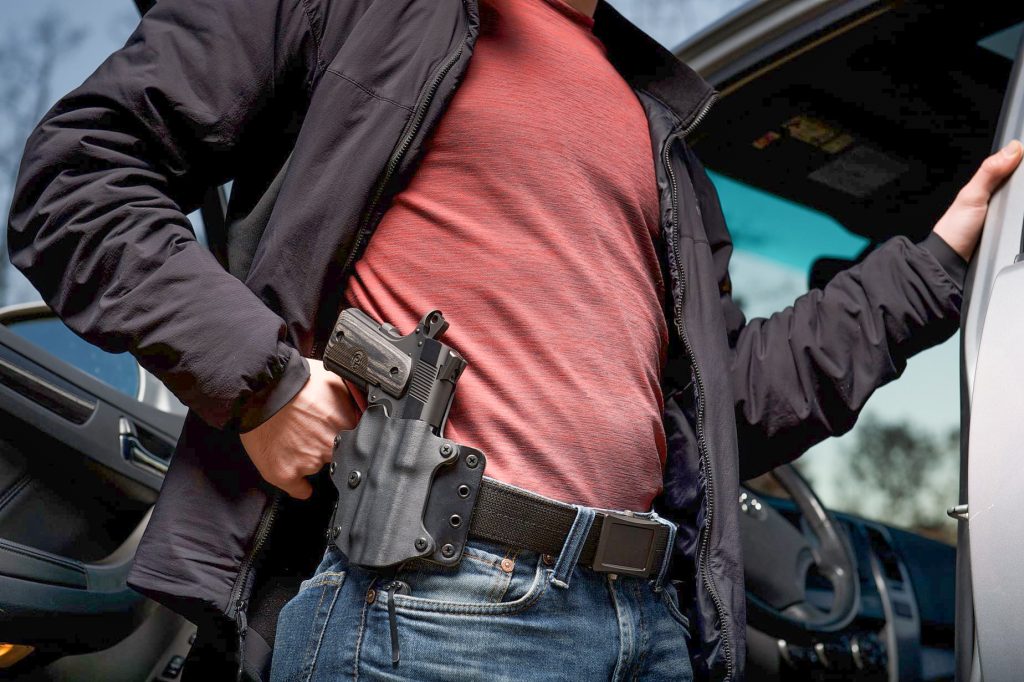
You might have to hit me over the head a few times, but I like to think I eventually learn. Thanks to Karl Rehn, we learned that most gun owners never take more advanced firearms classes than the minimum required to get their concealed carry permits. Add to that my state becoming the 28th state to adopt permitless carry.
I also analyzed some common incidents of armed self-defense recently, though that’s something I’ve done thousands of times before. Put all that together and I wonder if more gun owners will continue their training now that the artificial ceiling of a concealed carry permit is gone in much of America.
This flickering insight came to mind as I looked at the stories we’ve talked about in my podcast last month.
A defender at home at night stopped an intruder as the intruder came up the stairs to the second floor. As simple as that sounds, there are some advanced skills involved that tend to go unnoticed.
- Learn to live with a firearm in your home so your gun is both secure and quickly accessible.
- Learn how to use cover and concealment so you don’t get shot.
- Learn to shoot from unusual positions like crouching, kneeling, or lying down.
- Learn to shoot in low light situations like inside your home at 5:00 am.
- Learn the laws surrounding armed self-defense in your state so you understand if and when, you may have a duty to retreat.
A defender was attacked by her estranged husband who broke into their home at night. After she was attacked in her home, the female defender retreated to the front yard. Her attacker pursued her. She shot him as he ran her down. We don’t cover that in firearms safety or in concealed carry classes.
- Learn about restraining orders if you have an abusive partner or stalker.
- Learn to shoot as you move and, in particular, as you move backwards away from the threat.
- Again, learn to shoot in low light conditions.
- Learn how to turn your neighbors into “earwitnesses.”
- Learn what — and more importantly, what not — to say to the police.
A defender was at home on a weekday afternoon when a stranger came to his front door. The news story isn’t clear if the door was unlocked or if the homeowner opened the door to talk. The stranger pushed the homeowner out of the way and entered the home. The homeowner shouted for the intruder to stop and tried to push him back outside. The stranger hit the homeowner with a hammer. That is when the defender shot the attacker.
That’s too close for comfort and armed hand-to-hand defense isn’t taught in the first classes.
- Get in the habit of carrying at home.
- Again, lock your doors and windows to buy yourself time.
- Learn to shoot from the close-quarters retention position.
- Learn what — and more importantly, what not — to say to the police. (Hint: The hammer on the floor is important evidence.)
- Learn about the legal challenges you face any time you touch your firearm in an altercation.
These stories of armed self-defense are common. If you Google, you’ll see lots of similar reports every single day. However the self-defense skills required in these situations are considered advanced. We all want good self-defense habits ingrained when we need them in an emergency. No one argues that, but any skills we haven’t practiced recently typically aren’t available to us when under stress with adrenaline pumping.
Another valuable lesson is, we’re not as safe as we imagine. We’re probably being honest when we say we want the skills. At the same time, we don’t seem willing to put in the time, the money, and the attention to acquire and maintain those skills
Let’s start with the simple things first. I find dry fire practice to be easy and enjoyable. It’s also free. But I’m amazed at how many people don’t do it, preferring to count on luck.
I hope our culture of armed defense continues to grow. Though mostly concealed from public view, we are walking ambassadors for civic responsibility. Now that we have permitless carry in so many states, you don’t have to take a class and you don’t have to pay the government an entry fee to join the concealed carry club.
True, you might feel out of place at first as you carry a concealed firearm in public. That feeling is natural as you learn what to do and when to do it. While you rightly aren’t required to take classes, it’s still a very good idea. And the classes available are typically far better than what was taught in the government-mandated classes. They will clearly explain what we’ve learned from four centuries of living with firearms. Other people have done it and you can, too.
I still feel the responsibility of carrying concealed every time I put on a gun. I hope that more of us take up that challenge.
This article originally appeared at Slow Facts Blog and is reprinted here with permission.
